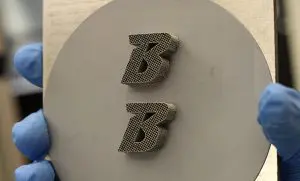A noteworthy trend in data centers is to reduce the power consumption of cooling facilities by increasing the supplied temperature to IT services, thereby requiring less work within the cooling facility to provide the targeted temperature. This will result in lower overall power consumption and higher computational effectiveness. However, higher inlet water temperature to the … [Read more...]
High-loading Graphene Composites Enhance Thermal Conductivity
It is well known that incorporating graphene fillers to the base (matrix) of a composite thermal interface material (TIM) can improve the resulting thermal conductivity of the composite. In fact, the intrinsic thermal conductivity of large graphene layers exceeds that of the high-quality bulk graphite, which itself is very high: 2000 W m−1 K−1 . But most of the studies of … [Read more...]
Analog Devices’ µModule Regulator Eases Data Center Cooling Requirements
Figure 1 Analog Devices LTM4700 combines high power with the energy efficient performance needed to reduce data center cooling requirements. To reduce data center infrastructure cooling requirements step-down DC/DC power regulators must combine high power with energy efficient performance. To that end Analog Devices has expanded its suite of Power by Linear … [Read more...]
New Way to Cool Data Center Chips Uses Laser Metal Printing
Figure 1: Researchers tested their technique by printing the Binghampton Univeristy logo with a 3D metal laser printer. Traditionally, electronics are cooled using a heat sink that transfers heat into the air or a liquid coolant. For the heat sink to work, it has to be attached to the CPU or the graphics processor via a thermal interface material, which helps facilitate the … [Read more...]
Making Electrothermal Co-Simulation a Reality
Taking on the challenge of placing ever more powerful electronics into increasingly small and complex devices has meant that electronic and thermal simulation are now vital parts of the engineering design flow. But with smaller geometries and higher power densities these challenges only get more acute. For starters the fact that the physical space within which electronic … [Read more...]
- « Previous Page
- 1
- …
- 17
- 18
- 19
- 20
- 21
- …
- 32
- Next Page »










